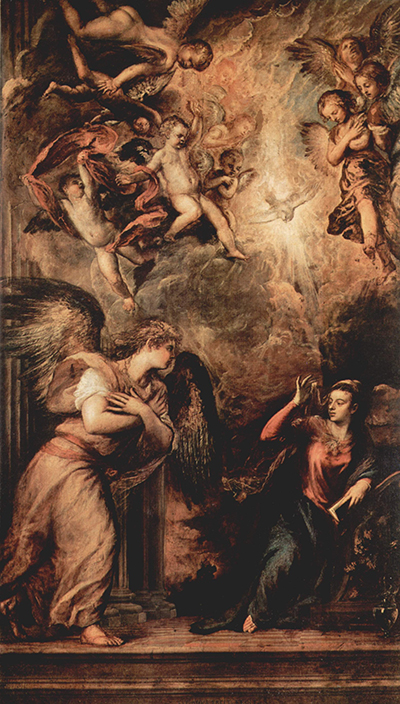The Annunciation is one of the later works of Titian, speculated to have been executed between 1560 and 1564.
This particular piece depicts the first phase of the incarnation of Christ when the Archangel Gabriel, delivered the news that Mary would be the Mother of Jesus.
The colours Titian used on the painting bring out the seriousness of the event. Some critics such as Charles Hope "disliked the muddy colours, the mannered pose of the Virgin and the inept use of gesture." From a different perspective, the style enhances the physicality of the characters and makes the spectator almost forget they are not real.
The Archangel Gabriel is painted in hues of gold, brown and a dash of red around his robe. He has his hands across his chests, in reverence of the Mother of God and his imposing figure emphasises his power as an archangel. Even his wings, painted in dark colours, don’t seem as fragile as they are usually depicted in other religious works.
Mary is in blood red and blue with one hand on her veil and the other holding onto a balustrade as if to support herself. Her demeanour is that of shock as she receives the news. The marble arches in the background and the tiled floor connect the otherworldliness of the event to the physical world. Titian blurs the outlines of the subjects with the warm colours.
Perhaps even more captivating besides the two primary subjects is what is happening just above them. As Mary lifts her veil to hear what the Archangel has to say, the heavens open up in a burst of light. There are angels on each side; some rejoicing and others bowed in reverence. Through the use of brighter colours, Titian shows a dove basking in the light from the sky.
The light shines on Mary and by doing so emphasises her role as the Chosen One. Measuring 403 by 235 cm with a marble frame, the size of the painting adds to its grandeur. The Annunciation was part of a three-piece art project for the high altar of the church of San Salvador Venice, commissioned by members of the church. Transfiguration and Crucifixion were the other two, but the latter was not hung in the chapel.
Titian’s style had changed quite a bit when he painted the Annunciation- it seemed more free and intimate compared to his earlier works. The painting also has a signature from Titian and the words "fecit, fecit" translated to "he did it, he did it." There have been speculations about what the phrase means; whether it was addressed to critics or if it was about the magnificence of the painting.
Titian has another Annunciation piece that was painted a few decades earlier. This particular one is simpler with the Archangel Gabriel holding a lily, delivering the news to a kneeling Mary.
Compared to the later piece, this one is quieter with no angels signing, no dove or burst of light. The earlier painting can be found at the Scuola Grande di San Rocco. Gerhard Richter painted an Annunciation after Titian. He got inspiration for the piece after seeing the earlier version of Titian’s Annunciation.
Titian, born Tiziano Vecelli was an Italian painter who hailed from the world-famous Venetian School. His year of birth is not clear but is estimated to be sometime after 1482.
He was versatile in his style from landscape backgrounds to portraits to religious suspects. Tiziano influenced the era of Italian Renaissance with his mastery of colour. Even as his style changed through the years, his love for colours was evident in each piece. Titian started out as a painter’s apprentice in Venice at the age of twelve or so.
Together with his brother, he began at the studio of Gentille Bellini then moved on to Giovanni Bellini. The Visitation of Mary and Elizabeth and Gypsy Madonna are recorded as some of Titian's first works.
Tiziano developed his style gradually over the years, moving from Giorgionesque to more complex pieces. After Giorgione and Giovanni Bellini died, Titian remained as the best in the Venetian School. He made a name as the master of Venetian Art. His most successful piece is the Assumption of the Virgin, which he made for the Basilica de Santa Maria Gloriosa Dei Frari. His last painting was the Pieta, which was finished by Palma il Giovane.




